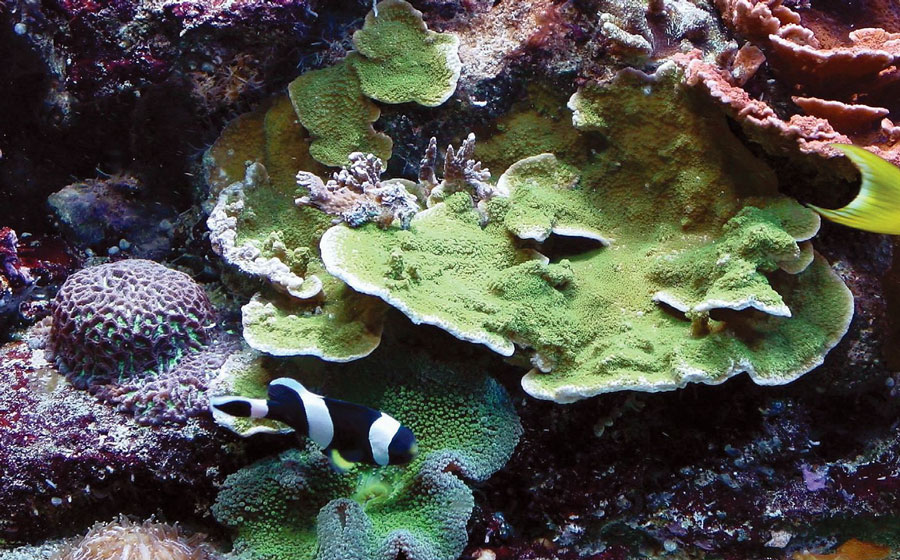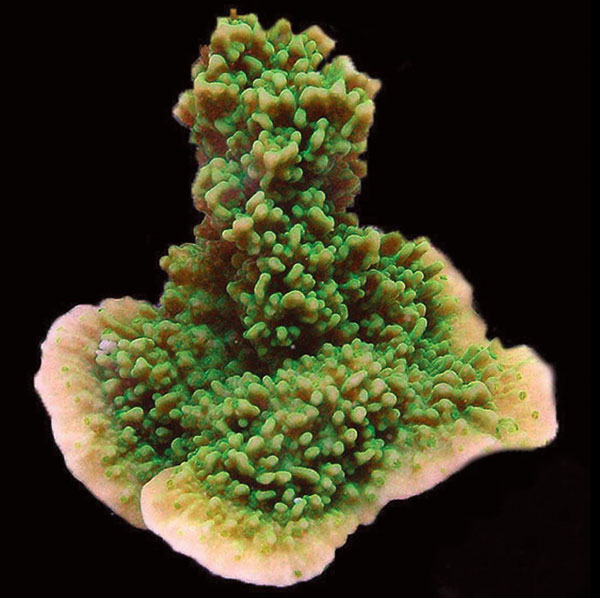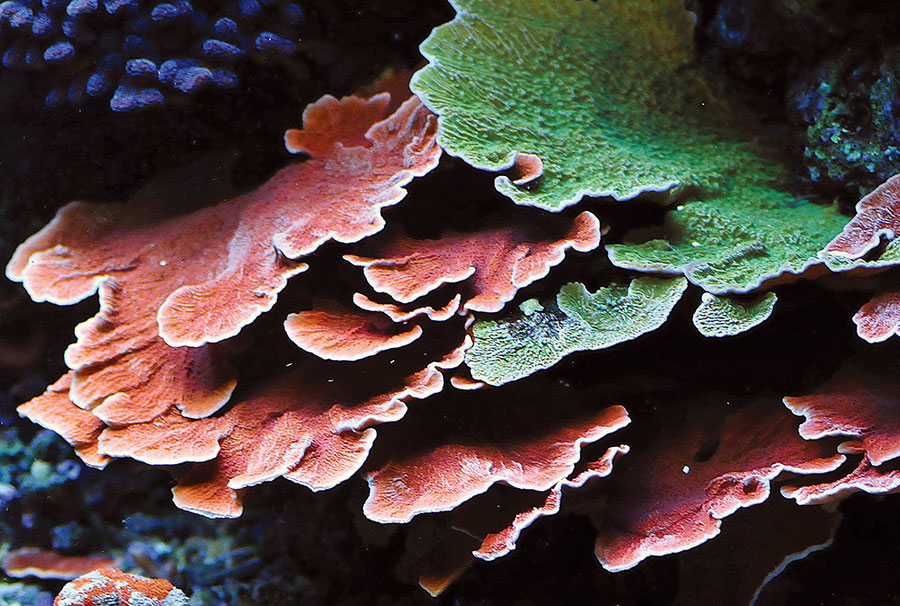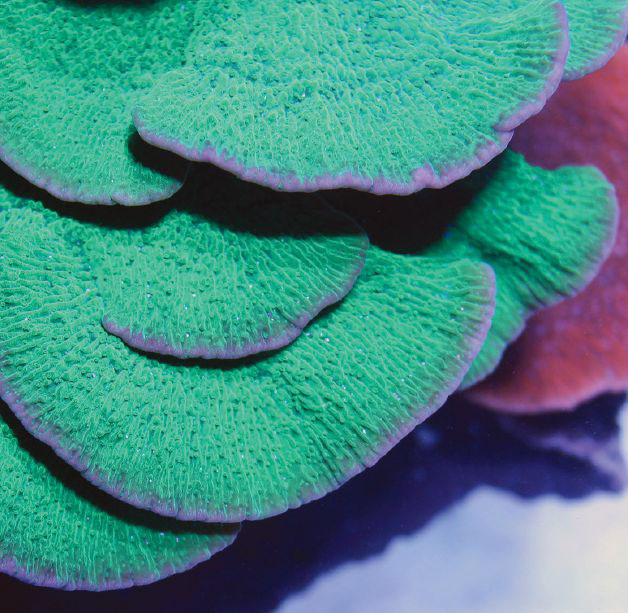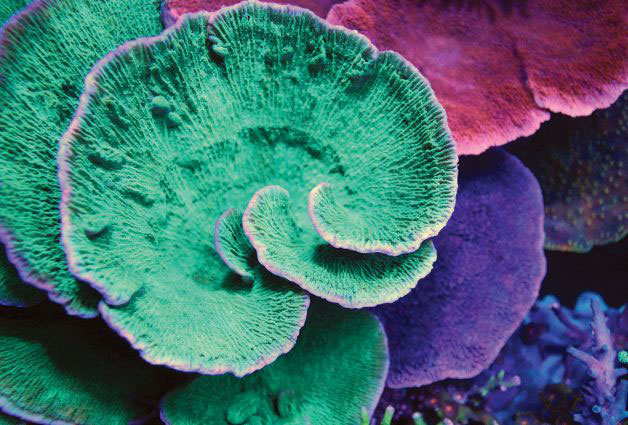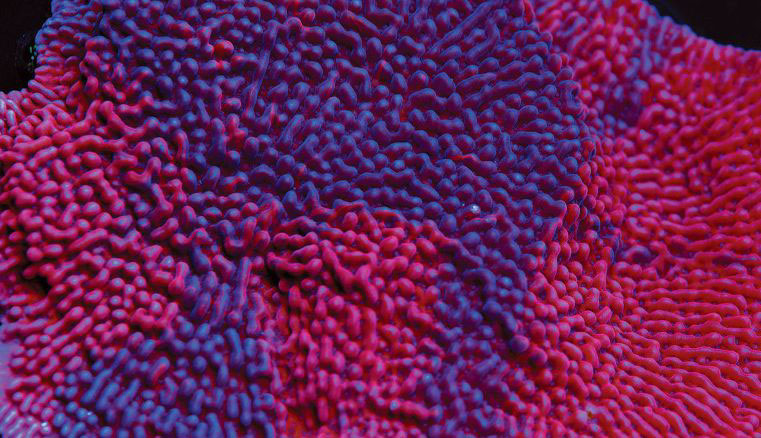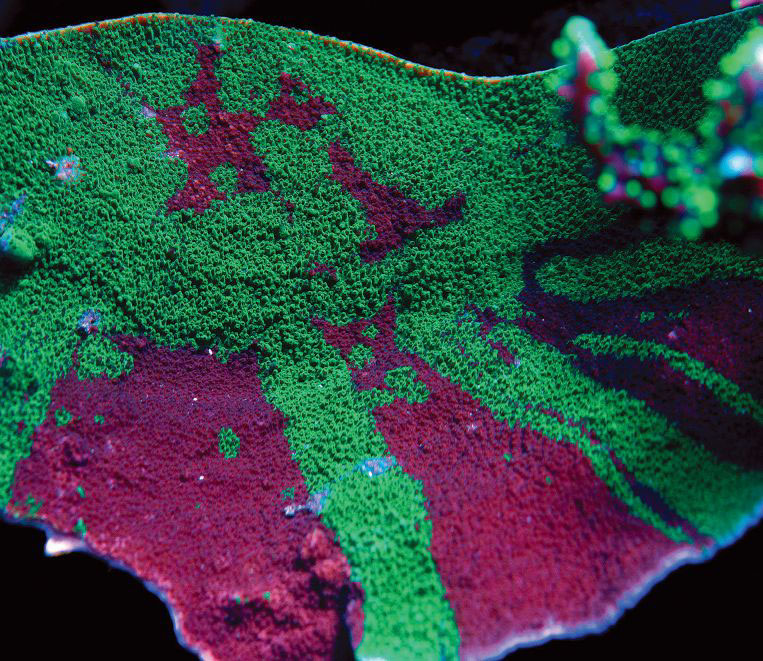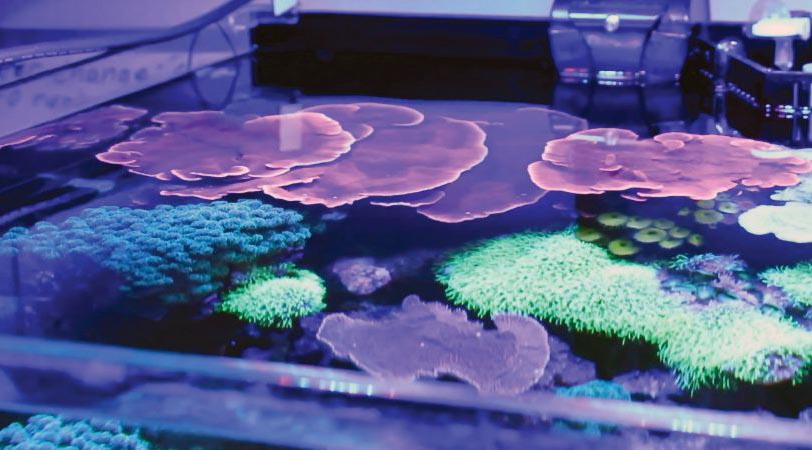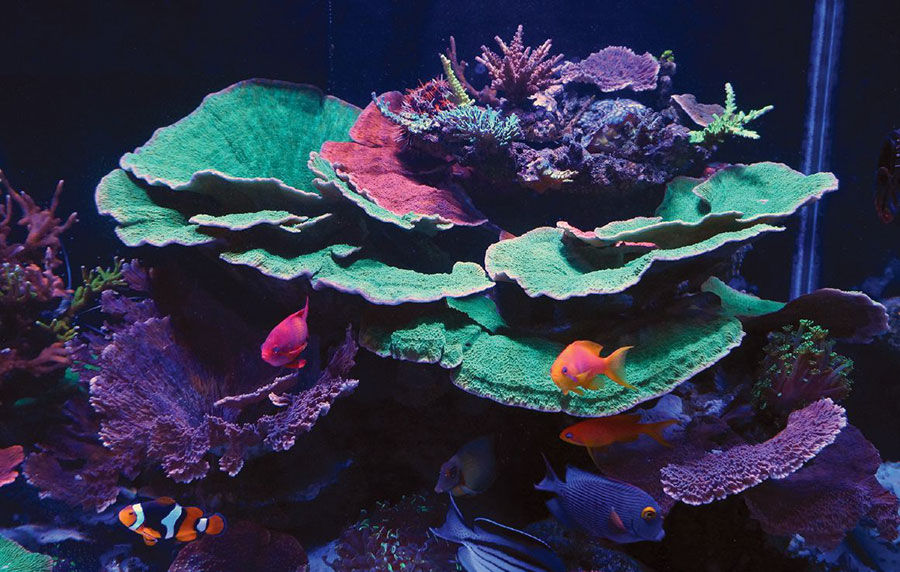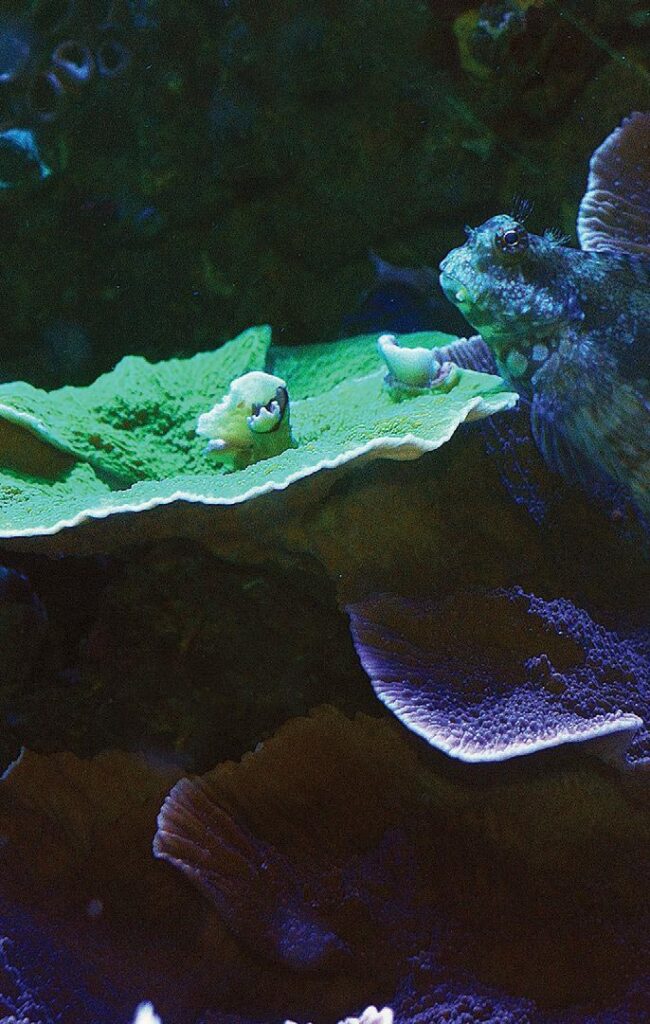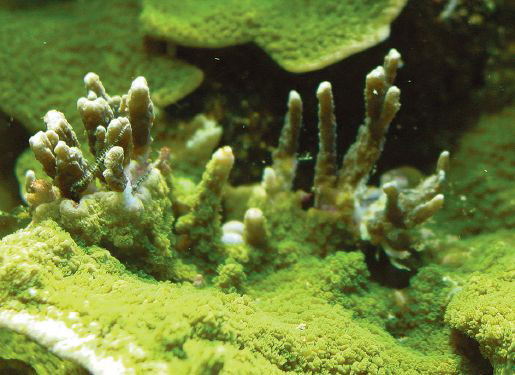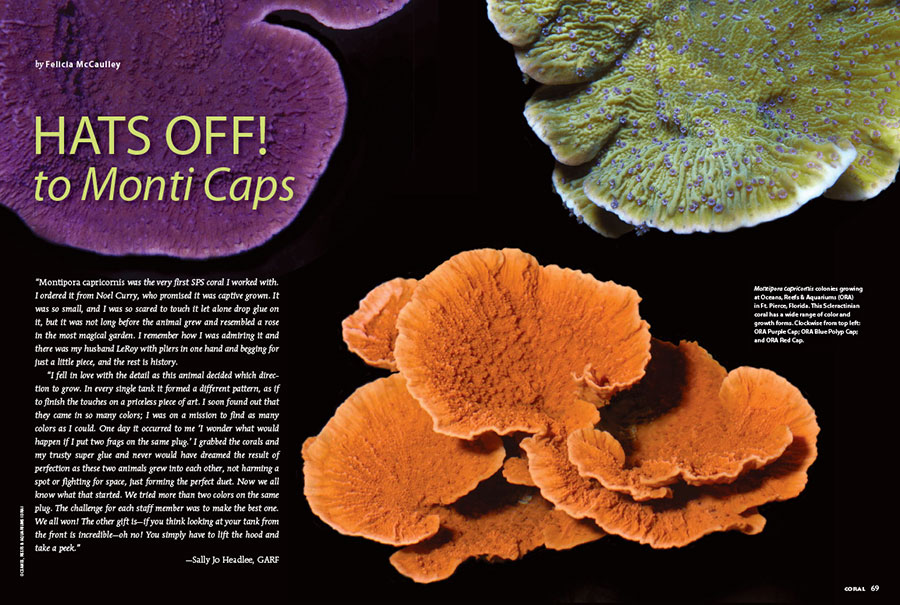
CORAL contributor Felicia McCaulley, along with the support of many talented photographers and coral culturists, presents an unprecedented modern look at the “Monti Caps” in the September/October 2018 issue of CORAL Magazine. In the opening spread, clockwise from top left: ORA Purple Cap; ORA Blue Polyp Cap; and ORA Red Cap. Image credits Oceans Reefs & Aquariums (ORA).
A special full excerpt from the September/October 2018 issue of CORAL Magazine
by Felicia McCaulley
“Montipora capricornis was the very first SPS coral I worked with. I ordered it from Noel Curry, who promised it was captive-grown. It was so small, and I was so scared to touch it, let alone drop glue on it, but it was not long before the animal grew and resembled a rose in the most magical garden. I remember how I was admiring it, and there was my husband LeRoy with pliers in one hand, begging for just a little piece; the rest is history.
“I fell in love with the detail as this animal decided which direction to grow. In every single tank it formed a different pattern, as if to finish the touches on a priceless piece of art. I soon found out that they come in many colors; I was on a mission to find as many colors as I could. One day it occurred to me, ‘I wonder what would happen if I put two frags on the same plug?’ I grabbed the corals and my trusty super glue and never would have dreamed the result of perfection as these two animals grew into each other, not harming a spot or fighting for space, just forming the perfect duet. Now we all know what that started. We tried more than two colors on the same plug. The challenge for each staff member was to make the best one. We all won! The other gift is—if you think looking at your tank from the front is incredible—oh no! You simply have to lift the hood and take a peek.” —Sally Jo Headlee, GARF
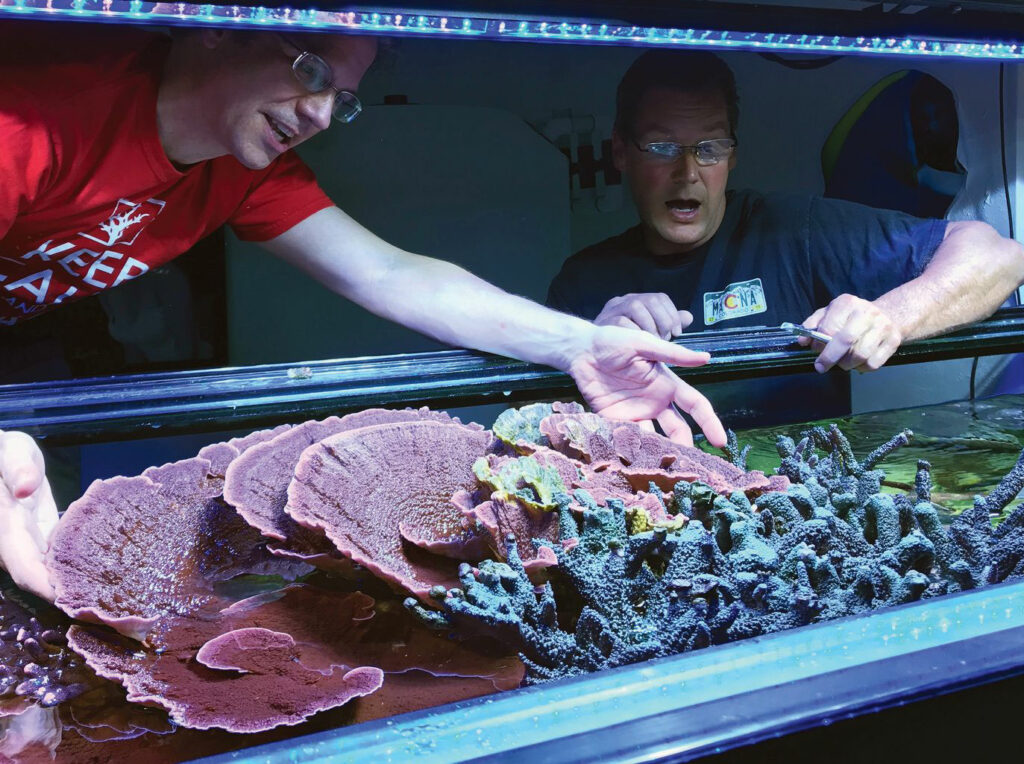
Marc Levenson of Melev’s Reef (left) and Duane Oestreich remove a large Montipora capricornis colony from Levenson’s 400-gallon reef. The growth was achieved over a period of less than three years. Image credit: Ryan Reeves
As marine aquarium pioneers and experimenters, Sally Jo and Leroy Headlee were co-founders of Geothermal Aquaculture Research Foundation (GARF) in Boise, Idaho. Like many other early reef enthusiasts, they quickly discovered that a certain beautiful stony coral was both forgiving in the hands of beginners and a wonderful, fast-growing species that literally invited the aquarist to experiment with fragging and home-scale coral farming.
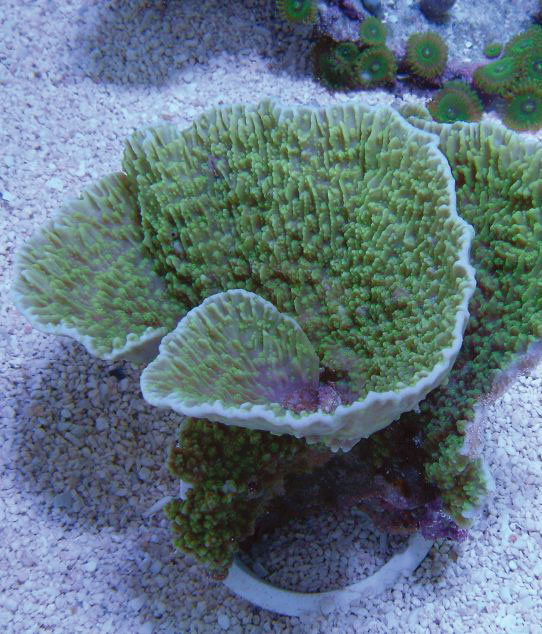
A young Monti Cap colony that is starting to develop the typical whorling growth form. Image credit: LiveAquaria.
Today, Montipora capricornis and similar sister species are probably the most popular and beloved scrolling corals in the reef aquarium hobby. They are usually brown, tan, or green on the wild reef, but red, pink, purple, and bright green forms are more common in home aquariums. Some strains have contrasting or colorful polyps. Their claim to fame is attention-getting shapes and reliable hardiness. Flat, uninteresting frag chips quickly grow into sculpted vase, plate, shelf, and scroll shapes. “Monti Caps” are less demanding and fragile than most other types of SPS corals and require a little less effort to turn into sprawling, impressive show pieces.
WHEN IS A MONTIPORA “CAP” NOT REALLY CAPRICORNIS?
Scrolling and plating Montipora are difficult to identify, especially as frags. It helps to know the collection location of wild colonies or the pedigree of a frag if you want to get a proper ID. An unlabeled frag might only be identifiable when it grows into a colony, but even then, it can be difficult. Depending on flow and lighting, these Montipora can develop into vastly different shapes in captivity than they would in the wild.
True Montipora capricornis colonies are flat plates growing in tiers, whorls, or spirals. They are also sometimes encrusting, columnar, or form thin blade-like plates. To make things difficult, a single colony of Montipora may exhibit more than one growth form. Corallites are immersed in a coarse coenosteum with no tuberculae or papillae. Rings or ridges growing around the plates’ center are often visible. Many of the wild “Monti Caps” sold in the aquarium livestock trade are actually M. foliosa, M. florida, or M. monisteriata.
- Montipora foliosa is the most common plating Montipora. It has a large native range and is often collected for the aquarium trade. It grows in a similar colony shape to M. capricornis, but the polyps form rows in between ridges running vertically from the centers to the outer edges of the plates.
- Montipora florida has large, fragile, upright plates that have small, inconspicuous papillae and polyps.
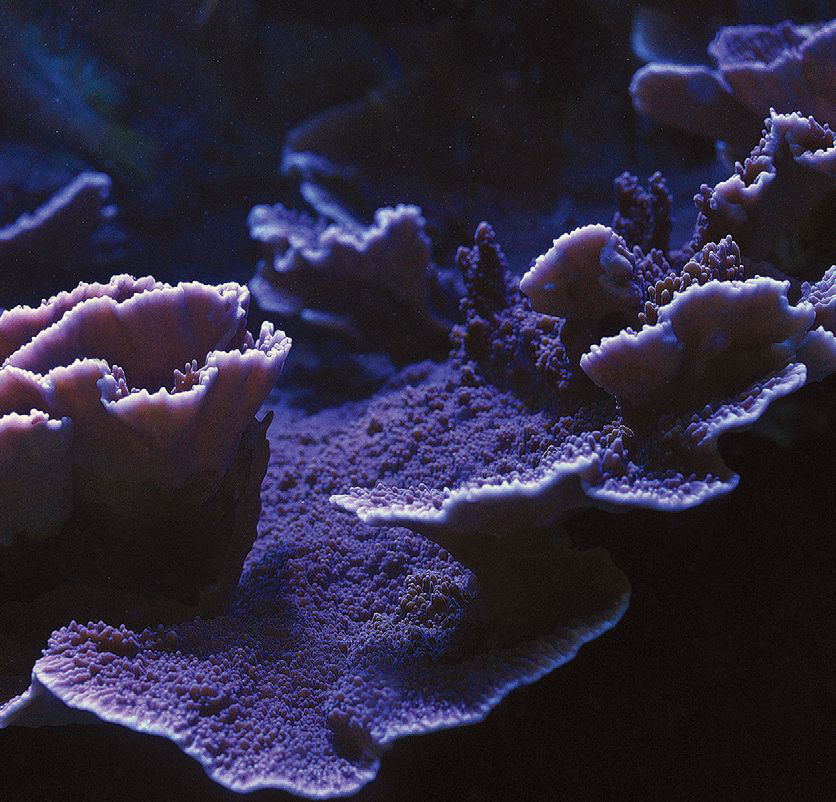
Section of a massive M. florida colony growing in a reef kept by the Williamsport, Pennsylvania “Tanks in Schools” Program. Image credit: Felicia McCaulley
- Montipora monasteriata grows wide, thick plates that don’t curl or form whorls. The plates grow outward or downward rather than up.
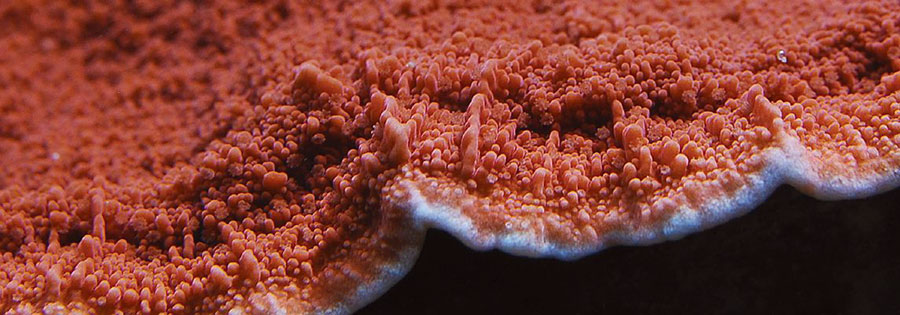
Orange M. monasteriata. Note white edge where new growth is occurring. Image credit: Felicia McCaulley
- Montipora hodgsoni, Montipora delicatula, and Montipora friabilis are less common, but are sometimes sold in the aquarium trade. In all, the genus Montipora has 85 valid species, and visual identification of live corals to the species level is a challenge even for experts.
SUPPLEMENTS, CARE, WATER QUALITY
Monti “Caps”—whatever the species—do best at temperatures between 75°F and 80°F (24–27°C). Maintain and balance calcium, magnesium, strontium, pH, and alkalinity. It’s best to use a calcium reactor and digital probes to do this. Some reefers dose liquid supplements and use imprecise test kits, but this approach can cause fluctuations and imbalances that can damage your corals. Montipora colonies in general love bright reef lighting and grow best near the top of the tank. To prevent bleaching, be sure to always acclimate your corals gradually to the lighting any time you get new coral, change bulbs, or install a new light fixture.
If your Montipora is becoming more pale or white, it needs to be better acclimated to your lighting or moved a bit lower in the aquarium. If you don’t want to move your frag, cut a few circles of fine black mesh found at hardware stores and stack these circles over the bleached coral to shade it. Remove a circle every couple weeks until the coral has adapted to the brighter lighting.
It is normal for Montipora to change colors when they are moved. If you notice your colony or frag is turning brown and losing its bright coloration, it may not be getting enough light. High organic nutrients in your system like phosphates and nitrates can also cause Montipora to turn brown by overstimulating the growth of the brown symbiotic zooxanthellae. Cut back on feeding your fish and corals, do bigger water changes more often, install a refugium or algae scrubber, and/or use an NPstyle bio-pellet reactor to help reduce these nutrients. Sediment and detritus regularly collect in the cup, vase, and scroll shapes of Monti Caps. SCWDs, gyre pumps, and wavemakers can create high, turbulent flow your Montipora will thrive in. If you’re into DIY projects, you can build a surge system that fills and flushes to mimic the high and low tides these corals experience in the wild. Don’t worry about having too much flow. The flow should be well dispersed instead of a single, thin jet of water. Buy the largest adjustable wavemakers you can, since you’ll need to increase the flow rate as your Montipora grow larger and impede the flow.
Most reef tanks produce enough nutrients to keep a Montipora well fed, along with adequate lighting, flow, and proper balance of calcium and alkalinity. If your reef tank has a low fish bio-load, dosing phytoplankton and amino acid supplements will encourage blooms of phytoplankton that will feed your Montipora and other SPS corals.
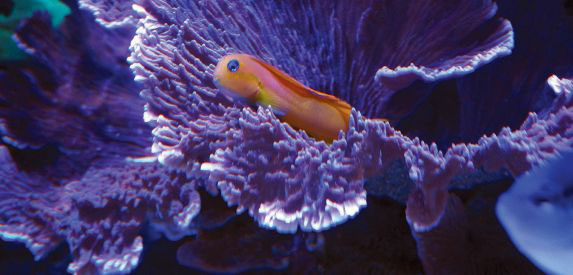
Midas Blenny, Ecsenius midas, perching in an unidentified colony, possibly Montipora hodgsoni. Image credit: Jason Langer
PLACEMENT
You may be able to manipulate the growth pattern of your Montipora by where you place them in the tank. Members of this genus will generally develop flat plates when they are placed closer to the light. Placing them closer to the middle level of the tank away from the light will cause them to grow a taller, vase-like shape as they attempt to gather more light. This can take some practice and experience, since too little light can cause them to lose coloration. Higher flow may also encourage them to create more intricate scrolls and patterns, while lower flow can cause them to grow in flat plates.
FRAGGING, GROWTH CONTROL
A successful Monti Cap will at some point need to be pruned to allow room for other corals in the tank. The outer edges are usually fragile enough to easily break off by hand. Thicker plates can be trimmed with coral “bone cutters.” If you’re fragging the coral while it’s inside the tank, be sure to stabilize it with one hand while cutting or breaking it with the other. Avoid touching the healthy tissue, wear gloves, and handle the coral gently by the base or underside. Use a coral wet saw if you want to turn an entire colony into frags quickly without stressing them. Wet saws continually cool the blade with water and cut cleanly. Some reefers use a Dremel tool, but it isn’t as quick as a wet saw, keeping the corals out of the water long enough to stress them. Dremel blades can also heat the tissue too much and cause damage. After cutting your frags, simply glue them to coral plugs with a significant blob of cyanoacrylate glue. Use epoxy putty and glue to attach larger pieces to rocks. Done properly, frags and colonies heal rather quickly from fragging and pruning.
-
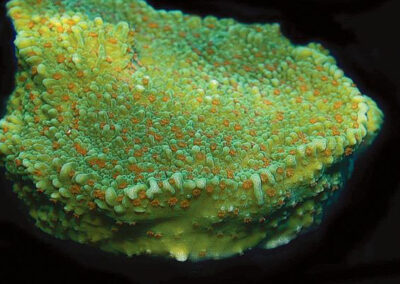
ORA Pink Polyp M. capricornis
-
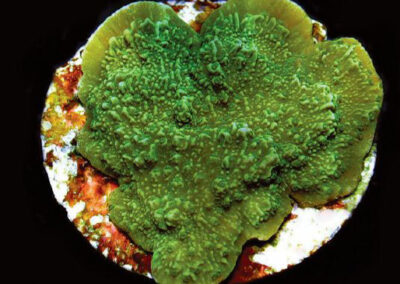
ORA Green M. capricornis
-
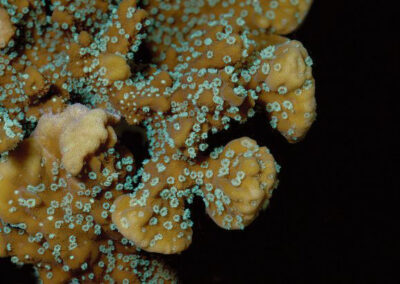
ORA Supernatural M. capricornis
-
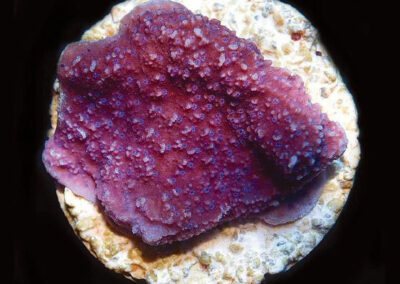
ORA Purple M. capricornis
If you have different colors of the same species of Monti Cap, you can graft the pieces together to create a multi-hued colony. Make cuts that will allow the frag pieces to fit together. Some grafted colonies have a half-and-half appearance or a checkerboard pattern made from square-cut frags, while some have more intricate patterns like spirals or puzzle pieces. The cut sides of the frags should be touching when you glue them to the frag plug. As the edges heal, they will often graft together and become one coral.
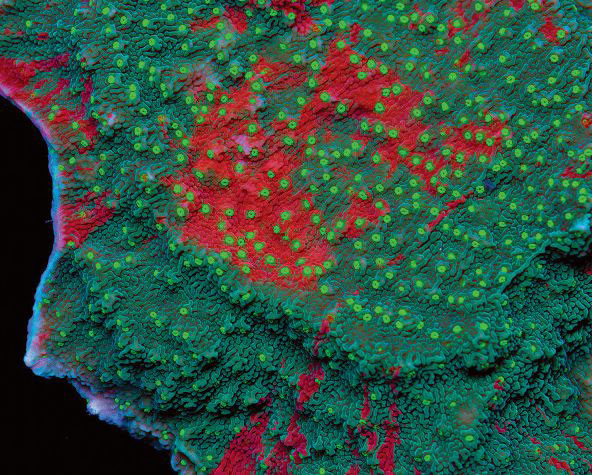
Above: Jason Fox “Sun Grafted Cap.” Note: Even novice coral fraggers can create grafted Montipora colonies. If you have different colors of the same species of Monti Cap, you can graft the pieces together to create a multihued colony. The graft is likely to fail if you attempt to fuse two different species of Montipora, and both frags may perish.
When done properly, grafted corals will exchange cells and colors between one another with a fused skeleton. Sometimes the corals don’t fuse well and remain two separate colonies while forming an obvious skeletal boundary. In this case, they will remain two separate colonies and will not share any cells or pigments. This usually happens when the two corals are different, similar species. Trying to fuse two different Montipora species usually results in the death of one or both colonies.
Other Monti Caps and other SPS corals with a condition called Green Fluorescent Protein Infection are sometimes referred to as grafted corals. No one is certain why some corals become infected with this green pigment, but it often happens when two SPS corals grow closely to one another. Coral propagator Justin Grable reports that it could be a viral gene set being turned on or a fungus-like thraustochytrid pigment infection.
PESTS
Montipora are less inclined to succumb to bleaching events and disease and are more heat tolerant than Acropora spp. and other more sensitive SPS corals. They do suffer from genus-specific pests like the dreaded Montipora-eating nudibranch. You may not realize your Montipora have a nudibranch infestation at first because these small pests tend to hide in the crevices and overhangs of the colony. The first sign of a problem is usually an obvious line of white exposed skeleton where the tissue has been rapidly consumed overnight. Similar to another Aeolid, the Zoanthid-eating nudibranchs, these are difficult to eradicate from a display tank. Since they often travel to other corals and live rock to seek new prey, it’s wise to dip and quarantine all new corals, not just Montipora, to prevent these pests. The hatched nudibranchs are damaged by coral dips, but the eggs are not. Dip the infected corals every other day until you’re certain there are no more egg masses. These nudibranchs are incredibly fecund and can seriously damage corals in a short amount of time. Some hobbyists have reported success using large doses of Salifert’s Flatworm Exit to treat Montipora-eating nudibranchs, but extreme caution should be used with this method.
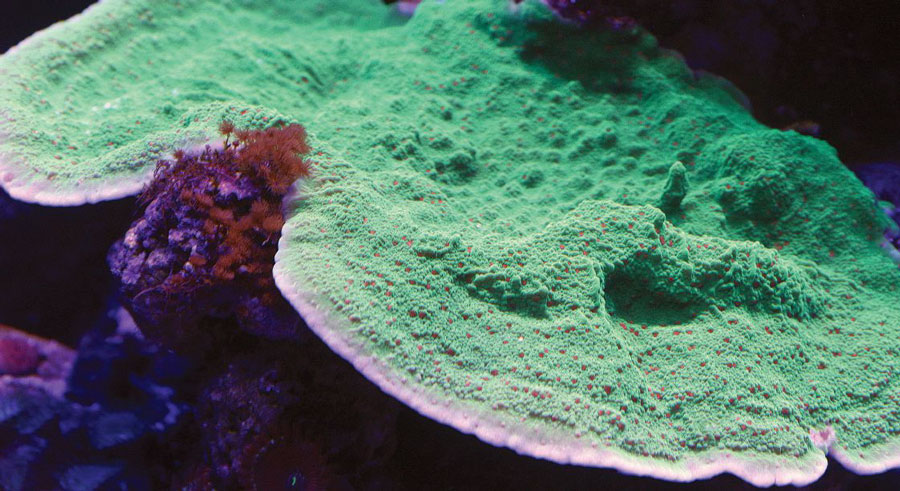
Montipora colony with patch of small brown hydroids diverting growth. Image credit: Robert Fanrsworth / Marine Depot
Montipora are susceptible to damage from stinging pests like Aiptasia anemones, Manjano Anemones, and colonial hydroids. The aquarist can kill these pests on sight with products such as Aiptasia-X, while dipping all new or afflicted corals in a bath with Two Little Fishies’ ReVive Coral Cleaner or Coral Rx Dip to prevent them from spreading.
FISH/CORAL COMPATIBILITY
Montipora are not as palatable as soft corals or corals with fleshy, exposed polyps, so they are not usually bothered by most corallivores like butterflyfish. Some groups like parrotfishes will bite and consume Montipora. Pufferfishes and triggerfishes may nibble on Montipora to condition their beak-like teeth. You should also avoid any very large fish, such as moray eels, that could break the plates with their movements or curiosity.
When placing new Monti Cap frags in your tank, try to envision them as grown colonies. Don’t place them where they will later overshadow other prized corals in your reef. Anemones and stinging corals such as Euphyllia spp. that put out long sweeper tentacles at night should be placed at least 6-12 inches (15-30 cm) away from the anticipated colony size of Montipora.
POPULAR PEDIGREED MONTI CAPS
Arguably the most recognizable and well-known pedigreed and cultivated strain of Montipora capricornis is the so-called “Leng Sy Monti Cap.” It’s a lovely shade of jade green with a lavender edge. What it makes it unique among similar Monti Caps is its unusual growth form. It has a typical plate formation, but in high light and flow conditions will grow finger-like pillars and lumpy projections from the plates. This strain has been around for about 30 years and is still highly desirable and often pricey.
Many local reef stores sell locally-grown Montipora colonies and frags. ORA in Florida and Drs. Foster and Smith’s Aquaculture Facility in Wisconsin are farming a large selection of Montipora capricornis strains and colors available for order through LiveAquaria.com. Collect them all! (Local aquarium retailers can easily source farmed corals at wholesale prices directly from ORA.)
Grafted Monti Caps like the World Wide Corals grafted “Starburst” and the Jason Fox “Cold Fusion” are becoming popular today. Grafted Monti Caps are more difficult to produce and can command higher prices.
You might think that the reef pioneers have done everything that can be done and there are no new ideas under the sun, but I urge fellow reefkeepers to never stop experimenting with your corals and pushing the envelope. Montipora capricornis is a species with so much potential and variable growth forms and colors; who can imagine what is possible? Now, go get your hands wet.
Felicia McCaulley is an experienced reef aquarist, staff member for a large retail aquarium business, and CORAL contributor. She lives with her family in Altoona, Pennsylvania.
REFERENCES
Borneman, E. H. 2001. Aquarium Corals. Pgs. 235-238. Microcosm/TFH, Neptune City, New Jersey.
Veron, J.E.N. and M. Staff ord-Smith.2000. Corals of the World, Volume I. Pgs. 62-167. AIMS, Cairns, Australia.
